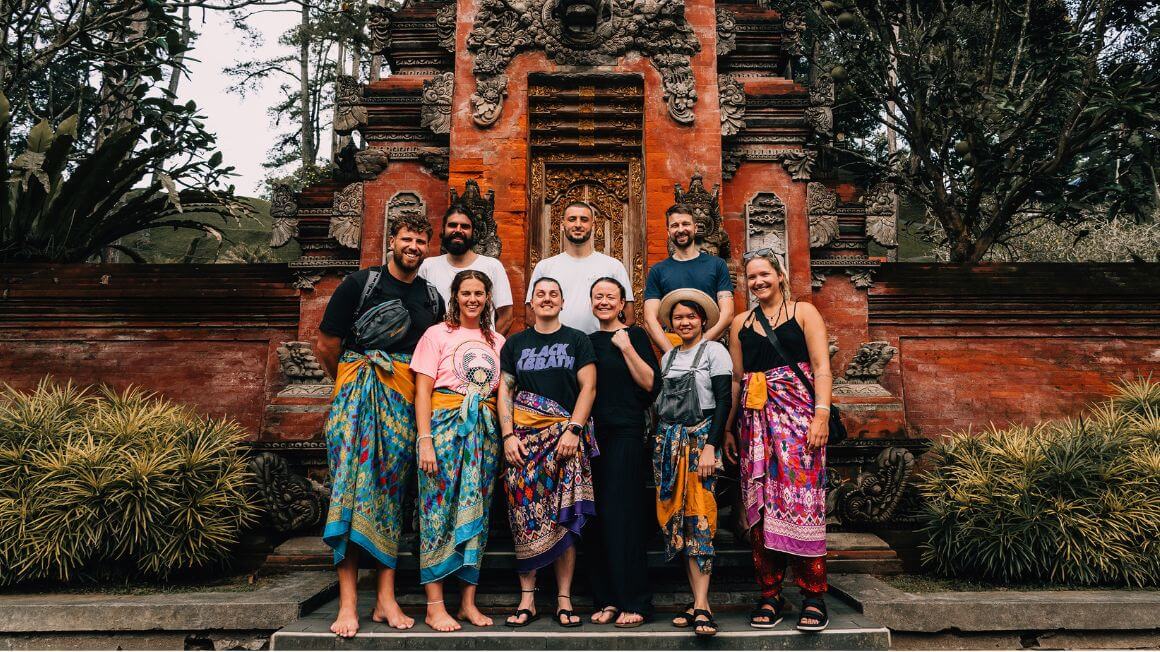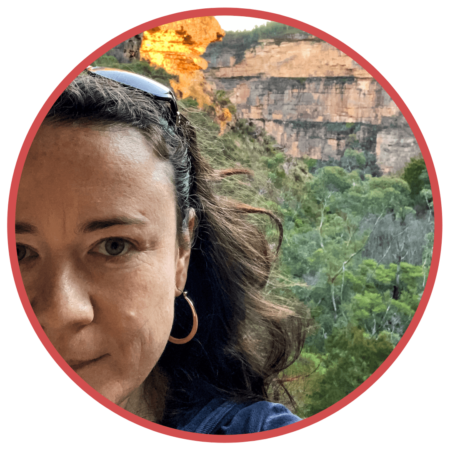The Broke Backpacker is supported by you. Clicking through our links may earn us a small affiliate commission, and that's what allows us to keep producing free content 🙂 Learn more.
If you’re craving epic mountains, wild landscapes, and roads that disappear into the unknown, Pakistan is calling. From the snow-capped peaks of the Karakoram to the alien coastlines of Balochistan, this country is rugged, raw, and refreshingly real. No crowded tours or self-stick mobs here – it’s just you, the road, and a whole lot of ‘wow!’.
Pakistan is made for backpackers, adventurers, and anyone who prefers mountain chai over hotel buffets. You’ll pass through glaciers, turquoise lakes, gorgeous valleys and desert beaches. You’ll also camp under the clearest night skies on the planet, and swap stories over bonfires with fellow wanderers.
And thanks to the legendary Pakistani hospitality, you’ll never be alone. Locals will invite you in for tea and show you places no guidebook covers.
So, are you ready to discover Pakistan? Get your snacks, your Spotify playlist, and a good spare tire. These are the best road trips in Pakistan.

The Broke Backpacker is supported by you. Clicking through our links may earn us a small affiliate commission, and that's what allows us to keep producing free content 🙂 Learn more.

Unlock Our GREATEST Travel Secrets!
Sign up for our newsletter and get the best travel tips delivered right to your inbox.
- Why Road Trip in Pakistan?
- Driving in Pakistan
- Best Road Trips in Pakistan
- Pakistan Road Trip Route 1: The Karakoram Highway Epic
- Pakistan Road Trip Route 2: The Northern Valleys Circuit
- Pakistan Road Trip Route 3: The Makran Coastal Adventure
- Insurance in Pakistan
- What to Pack for a Road Trip in Pakistan
- FAQs for Best Pakistan Road Trips
- Final Thoughts on the Best Pakistan Road Trips
- Buy Us a Coffee!
Why Road Trip in Pakistan?
Pakistan is a road-trip essential. Having your own wheels means freedom to chase sunrises over glorious giant peaks, stumble upon village festivals, and take detours that lead to discoveries no guidebook mentions. It’s literally the perfect way to explore Pakistan.
Here’s why you must road trip in Pakistan:
- Unmatched Mountain Scenery – Home to five of the world’s 14 highest peaks, including the mighty K2, Pakistan’s mountain and valley views are literally world-class.
- Cultural Immersion – Every village has its own dialect, customs, and incredibly welcoming people. You get to experience Pakistan’s diversity firsthand, from Punjabi truck art to Balti mountain culture.
- Adventure Accessibility – Whether you want to camp wild under the Milky Way or stay in cosy guesthouses, Pakistan’s road network puts epic adventures within your easy reach.
- Dirt-Cheap Costs – Fuel, food, and accommodation won’t break the bank, meaning you can road trip for weeks on what you’d spend on a weekend in Europe.
- The Ultimate Bragging Rights – Pakistan remains refreshingly off the beaten path. You’ll return with stories that’ll make other travellers jealous.
Driving in Pakistan
Driving in Pakistan is like a masterclass in defensive driving – part thrilling, part terrifying, but totally doable. The main highways, especially the Grand Trunk Road and Motorway system, are surprisingly excellent, with smooth tarmac that can handle serious speeds. But venture into the mountains or rural areas, and you’re looking at everything from decent metalled roads to bone-rattling jeep tracks that require skill, patience, and probably a few prayers.
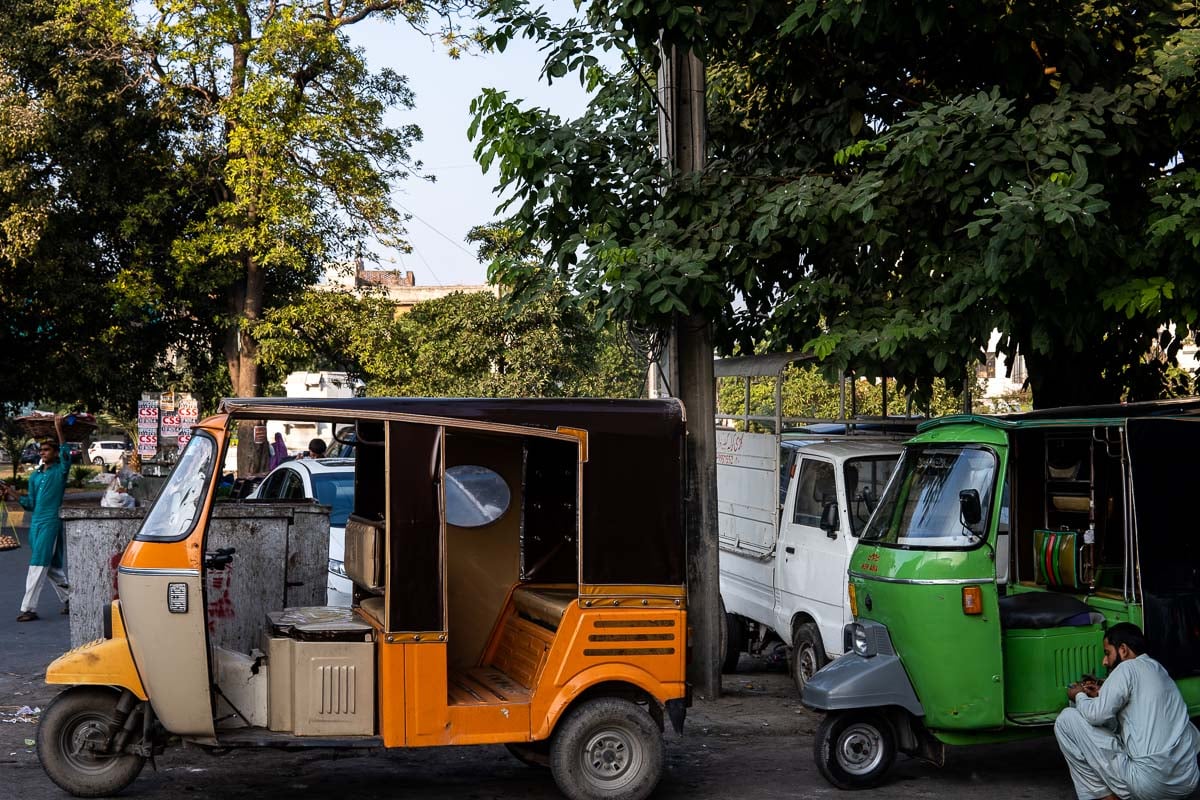
Traffic can be chaotic in cities – think honking as a form of communication, colorfully decorated trucks that own the road, and motorcycles carrying entire families. Mountain passes require confident driving skills, especially on the Karakoram Highway where landslides and rockfall are the main concerns.
Fuel is cheap and fairly easy to find in most towns. That said, always top up before heading into remote areas. Google Maps mostly works, but it’s smart to have offline maps downloaded, especially in valleys with no signal. Road signs are usually in both Urdu and English.
Renting a Vehicle in Pakistan
Renting a car in Pakistan is very different from renting a car in most countries, as it’s very hard to find companies that will give you a car to actually drive. Rentals here almost all come with a driver, and you won’t find the international companies you’re used to.
If you want to motorbike in Pakistan, the rental process is significantly easier and they’re usually around $20-$30 USD per day. While you won’t be asked for it, I highly recommend making sure following any license requirements set by your travel insurance.
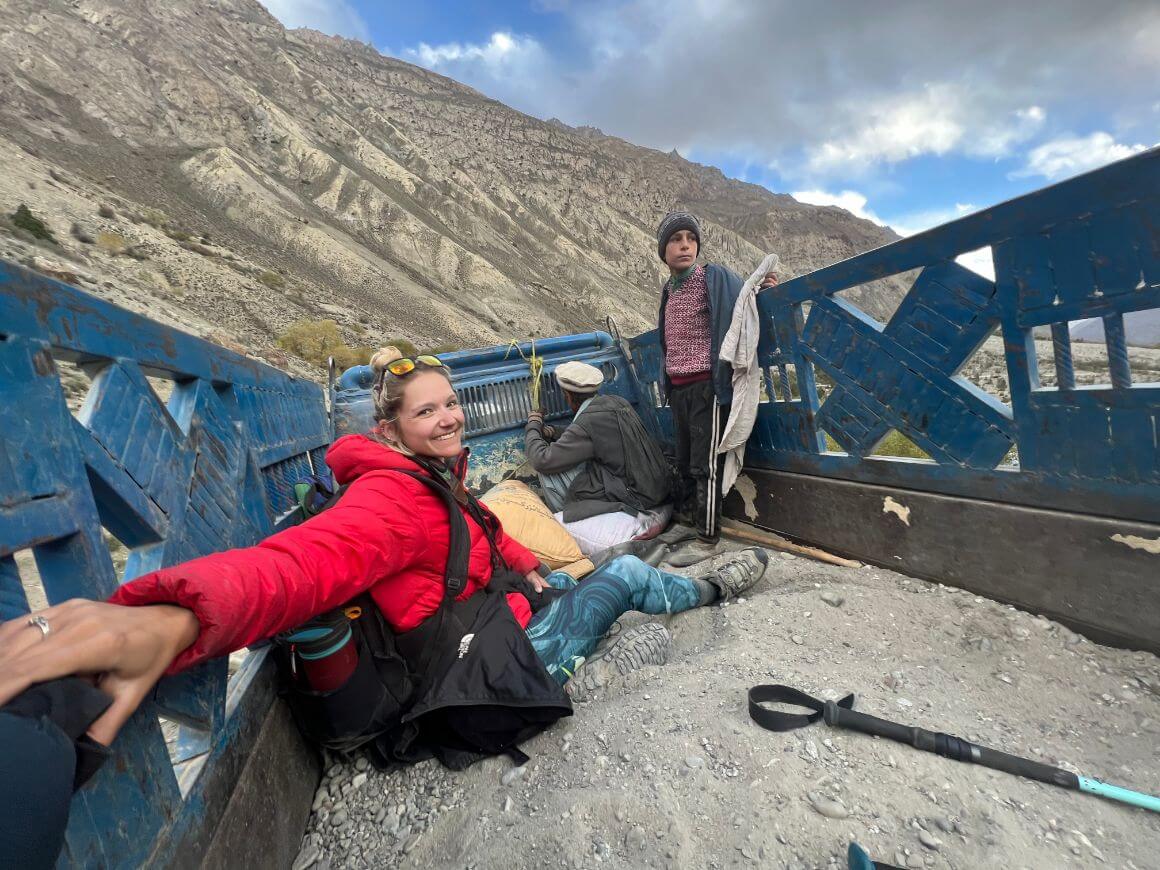
For mountain adventures, your only option is hiring a 4WD with a local driver who knows the terrain. It’s often cheaper than self-drive and infinitely less stressful on challenging routes like the Karakoram Highway.
It IS possible to rent cars sometimes in cities, but keep in mind there isn’t really insurance in Pakistan so you’d be responsible for all damages. This makes getting a driver even more appealing!
Road Rules in Pakistan
Pakistan drives on the left side of the road (British colonial legacy), but don’t expect British driving etiquette! The traffic philosophy here is more “organized chaos” than rigid rule-following. Honking isn’t rude, it’s essential communication, especially when overtaking. Lane discipline is…well, expect motorcycles weaving through the traffic.
Speed limits exist (usually 120 km/h on highways, 50-80 km/h in cities) but enforcement is inconsistent except on major motorways where traffic police are active. Traffic lights and signs are generally respected in cities, though roundabouts can become free-for-alls during rush hour.
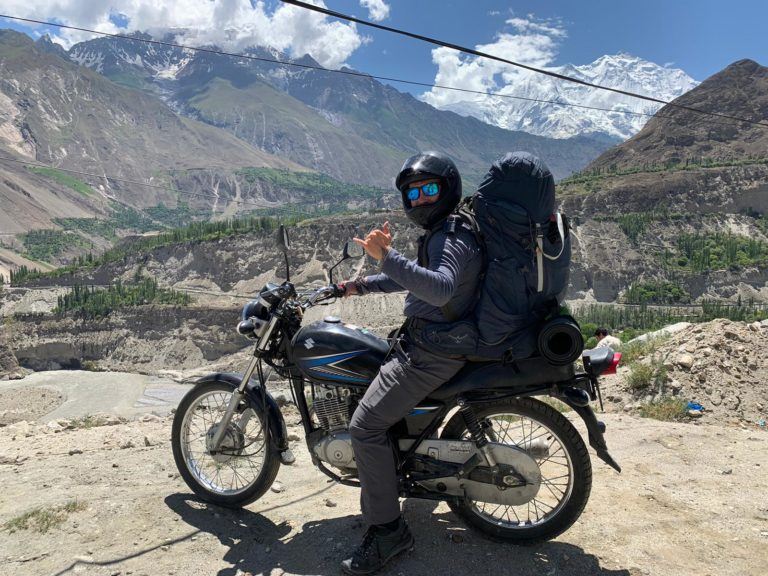
The key is defensive driving: assume other drivers haven’t seen you and always have an escape route planned, especially if travelling by motorcycle. Watch for livestock on roads, especially at dawn and dusk – cows, goats, and buffalo don’t follow traffic rules!
The golden rule: patience and humor will get you further than aggression. Pakistani drivers are generally helpful and will often guide lost foreigners, so don’t be afraid to ask for directions.
Best Road Trips in Pakistan
Ready to hit the road? These four epic routes showcase Pakistan’s incredible diversity – from legendary mountain highways to ancient desert paths.
- The Karakoram Highway Epic – 7-10 Days
- The Northern Valleys Circuit – 5-7 Days
- The Makran Coastal Adventure – 4-6 Days
Pakistan Road Trip Route 1: The Karakoram Highway Epic
- From: Islamabad
- To: Khunjerab Pass (China Border)
- Total Distance: 820 km (510 miles)
- Days: 7-10
- Top Road Trip Stops: Hunza Valley, Rakaposhi Viewpoint, Attabad Lake, Altit & Baltit Forts, Khunjerab Pass
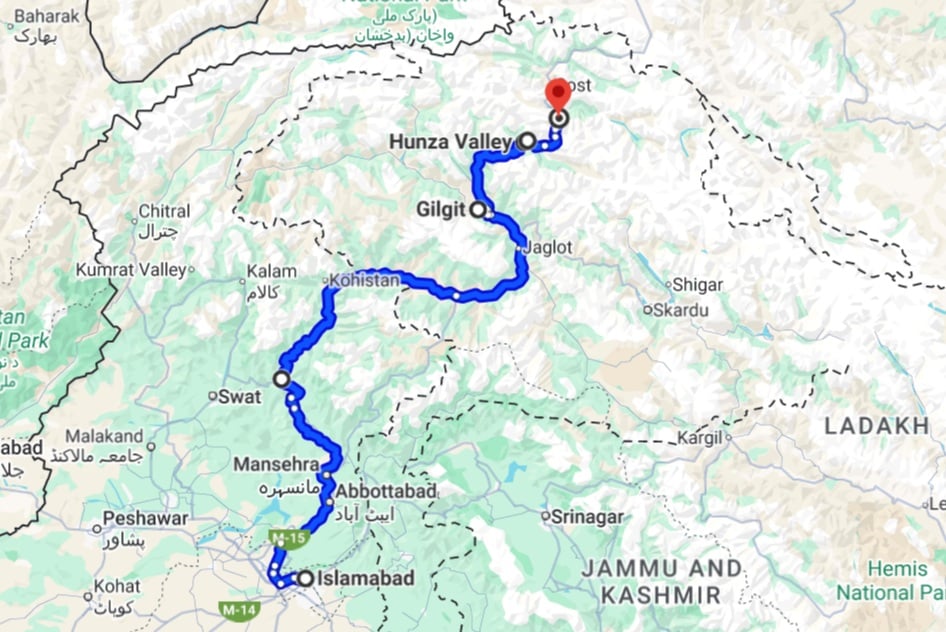
This is the road trip to conquer in Pakistan. The Karakoram Highway (KKH) is legendary. It is one of the highest paved roads on Earth, snaking through some of the most dramatic mountain scenery, connecting Pakistan and China. You’ll cruise past 7,000-meter peaks, turquoise glacial lakes, and ancient forts looking over friendly villages.
It’s a slow ride through scenery that punches you in the face (in a good way). Perfect for serious road trippers who want bragging rights for life, this route demands nothing but just wheels, time, and a taste for altitude.
Road Trip Highlights:
- Drive the legendary Karakoram Highway, one of the world’s highest paved roads
- Explore the fairy-tale Hunza Valley with its ancient forts and apricot orchards
- Marvel at Rakaposhi peak (7,788m) from the famous viewpoint
- Boat across the stunning turquoise Attabad Lake
- Stand at Khunjerab Pass (4,693m), the highest border crossing in the world
Day 1: Islamabad to Besham (5-6 hours)
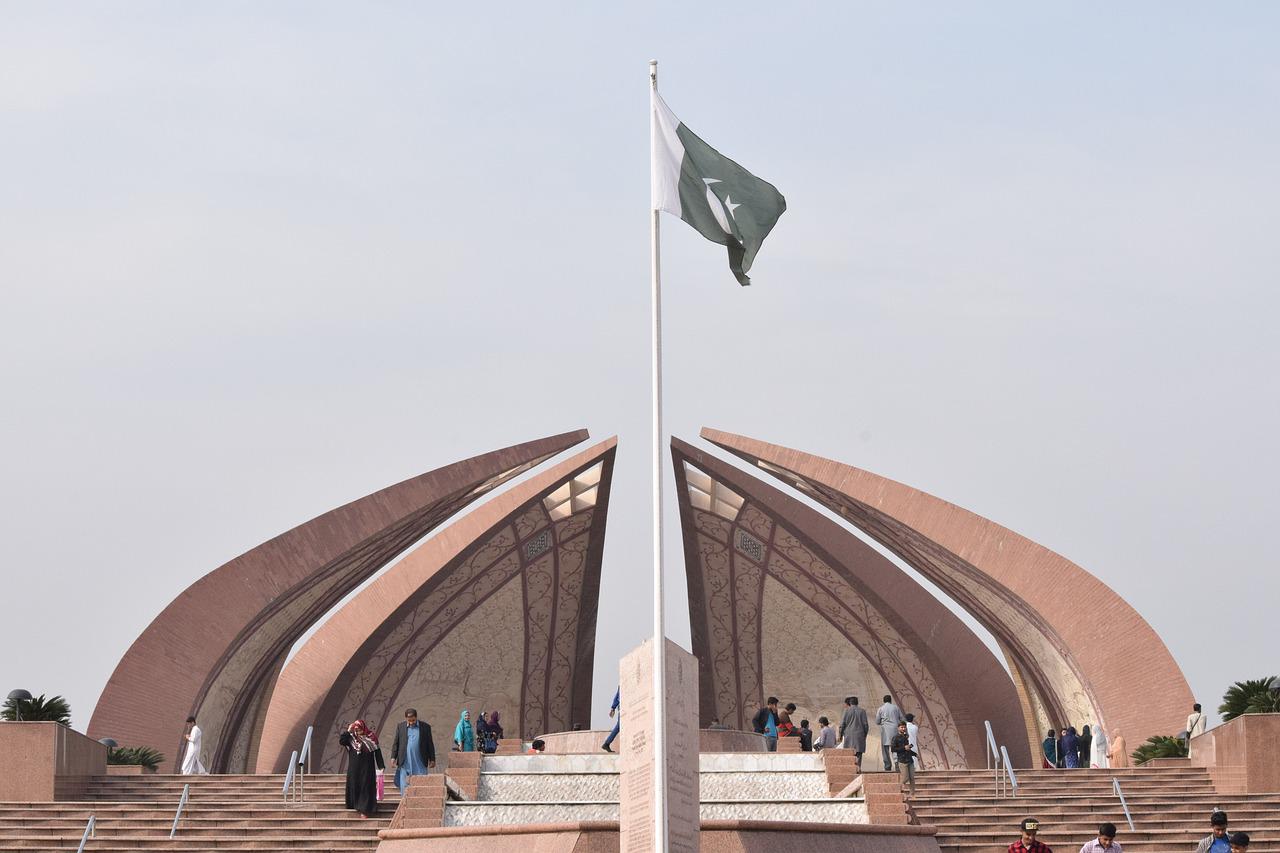
Your epic mountain adventure begins with a steady climb out of Pakistan’s capital into increasingly wild terrain. Drive the N-35 through the first stretch that follows the Grand Trunk Road through Punjab’s agricultural heartland. By afternoon, you’ll be winding through the first proper mountain passes with views that hint at what’s to come.
Besham, a dusty mountain town that’s really only meant for a night to sleep, is your first overnight stop, where you can grab your last taste of lowland Pakistan before diving deep into the Karakoram.
- Best Stops: Abbottabad (hill station charm), Kaghan Valley turnoff (if time permits), first mountain viewpoints
- Where to Eat: Hunza Midway Point Hotel
- Where to Stay:
- There aren’t good options, honestly. The only passable one is the above with barebones facilities. But hey, it’s just for an overnight sleep-in, right?
Day 2: Besham to Gilgit (12+ hours)
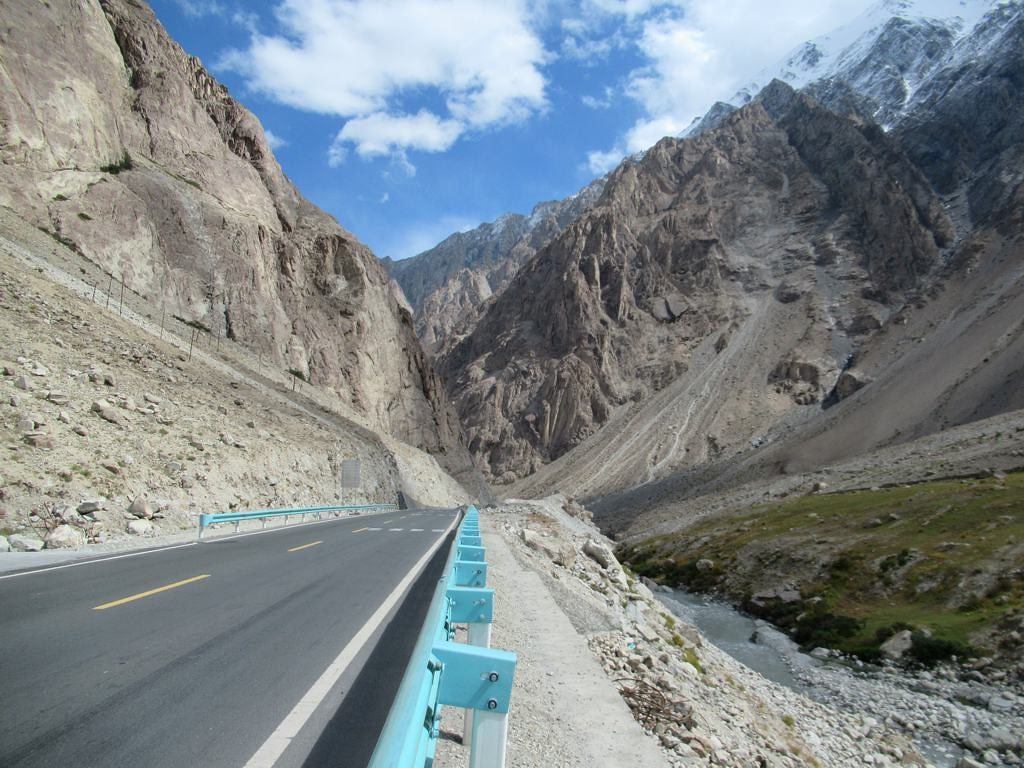
Today’s when things get properly wild. You’ll drive along cliff edges with the Indus River churning far below, pass through the dramatic Indus Kohistan region, and witness landscapes that seem almost alien in their stark beauty.
This stretch is pure adventure – hairpin bends, occasional rockfall zones, and mountain views that’ll have you pulling over every few kilometers for photos. The mountain town of Gilgit will welcome you as the gateway to the real Karakoram, and the last resupply point before the high passes.
- Best Stops: Indus and Gilgit River confluence, first glimpses of Rakaposhi, Gilgit Bazaar
- Where to Eat: Madina Hotel Restaurant, Mountain View Restaurant
- Where to Stay:
Day 3: Gilgit to Karimabad, Hunza (2-3 hours)
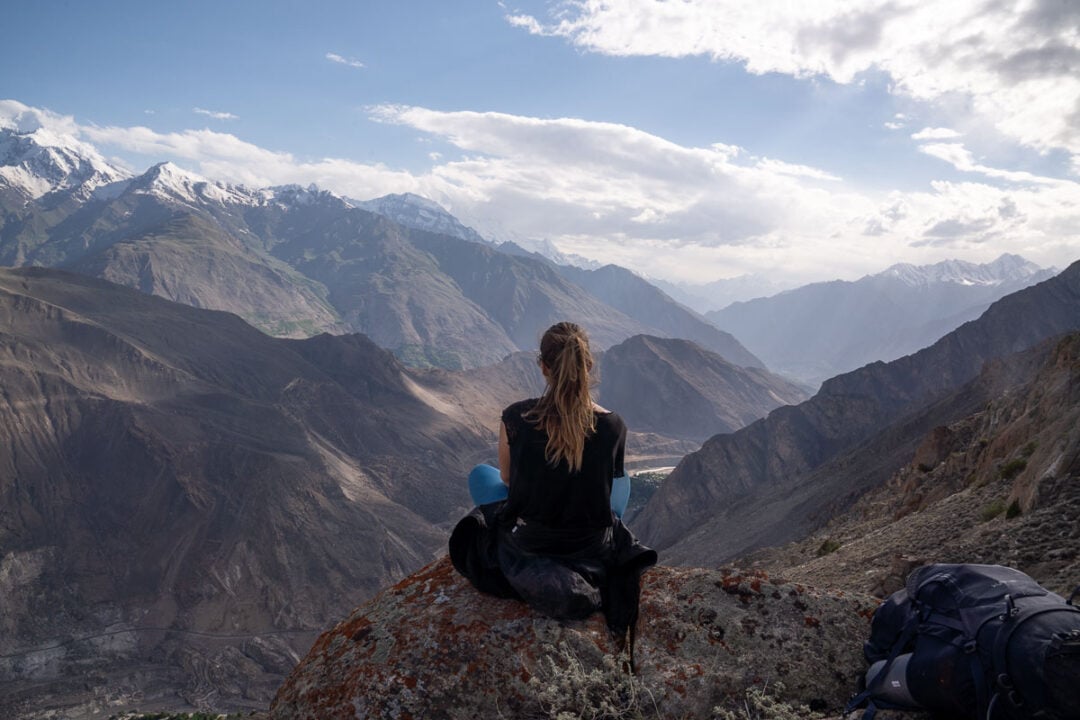
This one’s a short drive, but with a massive payoff – majestic legendary Hunza Valley, a place so beautiful it inspired the fictional Shangri-La. The road winds through increasingly lush terrain until suddenly you’re surrounded by snow-capped peaks, terraced fields, and ancient forts perched on cliff edges.
Karimabad is your base for soaking in your first taste of Hunza Valley’s hospitality and highlights. Grab a cup of chai with a view – stopping at the viewpoint for Rakaposhi, the 27th highest peak on the planet that stands like a massive white pyramid. This is where many travelers extend their stay, and for good reason!
- Best Stops: Rakaposhi Viewpoint, Baltit Fort, Altit Fort, Karimabad’s old town
- Where to Eat: Cafe de Hunza (walnut cake, pancakes, and epic views), Tree House Cafe
- Where to Stay:
Day 4: Explore Hunza Valley
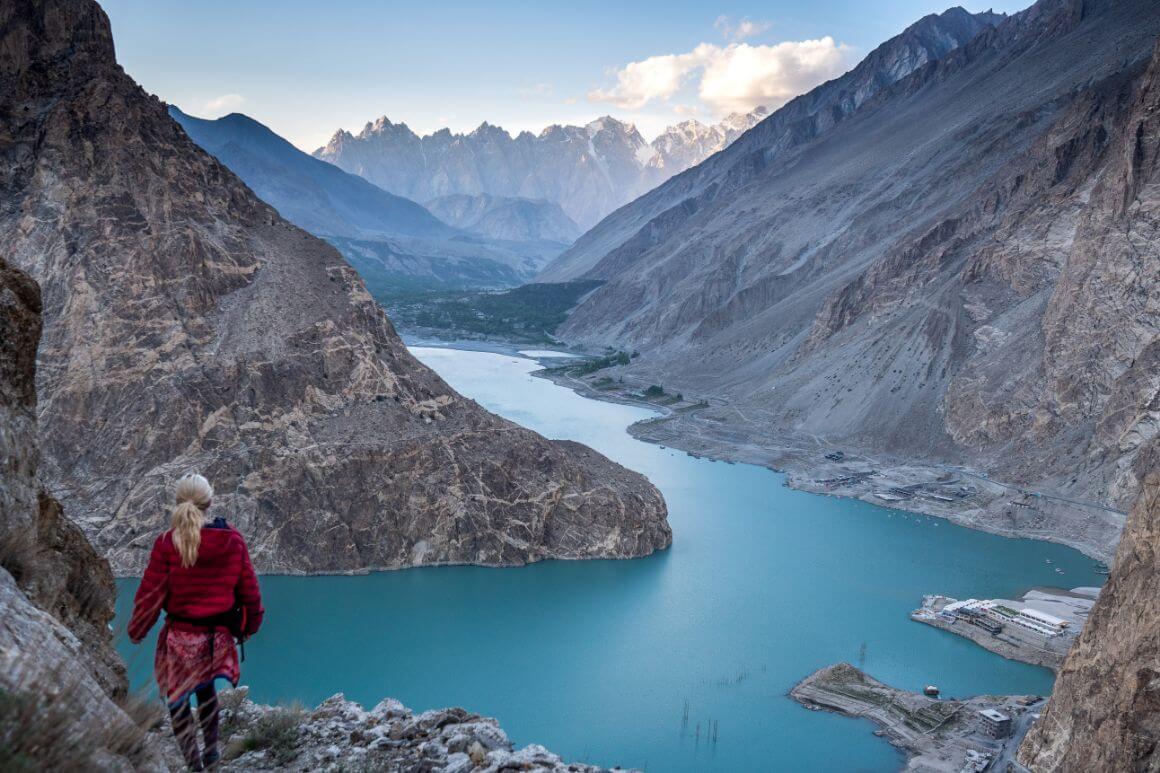
Take a full day to explore Hunza properly without the pressure of driving. Hike to the ancient Altit Fort for sunrise views, wander through apricot orchards, or take the challenging trek to Eagle’s Nest for amazing panoramic valley views.
The valley’s unique culture, a blend of Central Asian and South Asian influences, makes every interaction fascinating. If you’re feeling adventurous, hire a local guide for glacier hiking or visit traditional villages.
- Best Stops: Altit Village walk, Hunza River viewpoints, local apricot farms, traditional craft workshops
- Where to Eat: Hunza Food Pavillion, Café Culture Hunza,
- Where to Stay: Same as Day 3
Day 5: Karimabad to Passu (2 hours)
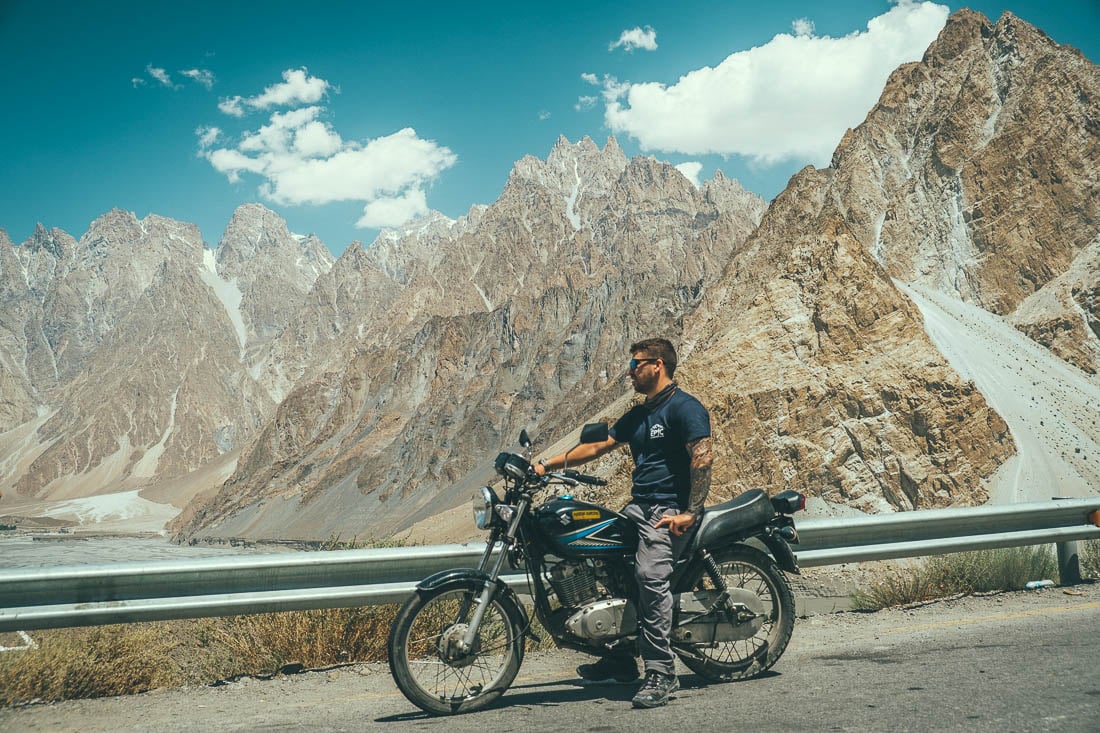
This short hop is packed with WOW! It takes you deeper into Hunza’s upper reaches where the landscape becomes even more dramatic. Passu village sits beneath some of the most photogenic peaks in Pakistan, including the famous Passu Cones (Cathedral Ridge).
The drive itself is spectacular, passing the stunning turquoise Attabad Lake, which was created by a massive landslide in 2010. Here you’ll need to take a boat transfer. Passu offers front-row seats to some of the world’s most impressive mountain architecture.
- Best Stops: Attabad Lake boat ride, Passu Cones viewpoint, Borith Lake, suspension bridge walks
- Where to Eat: Yak Grill, Glacier Breeze Restaurant (apricot cake), local tea houses
- Where to Stay:
Day 6: Passu to Sost/Khunjerab Pass (3-4 hours)

This is the grand finale – your push to the roof of the world. Drive north through the epic dry valleys and yak territory of this national park until you reach Khunjerab Pass, 4,693 m above sea level. It’s windy, cold, and totally epic!
The views are literally breathtaking (and not just from altitude), with massive peaks stretching endlessly in every direction. Sost, just before the pass, is the last town before China. The sense of achievement at reaching this remote corner of the world is indescribable.
- Best Stops: Khunjerab Pass (China border), high-altitude wildlife spotting, endless mountain photography
- Where to Eat: There’s plenty of cheap Pakistani restaurants in Sost, but limited options further ahead
- Where to Stay:
- No hotels at the pass, return to Passu (Day 5 hotels) or stay in local guesthouse at Sost.
Day 7-10: Return Journey & Side Explorations
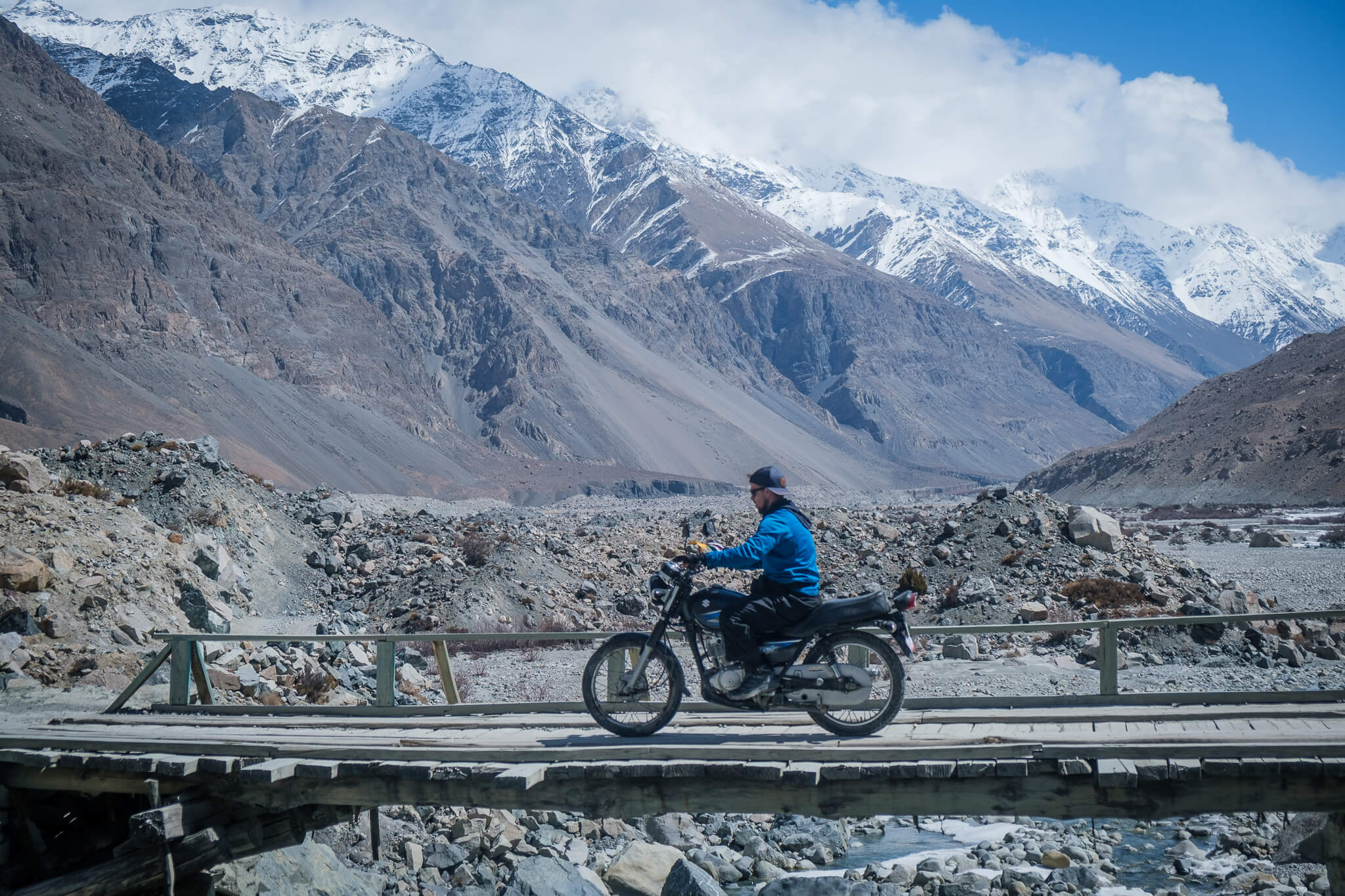
The return journey offers completely different perspectives on the same spectacular scenery, plus opportunities for detours you might have missed. Consider side trips to Nagar Valley, extended stays in Hunza for trekking, or exploring Gilgit’s surrounding valleys.
If you have a day or two to spare, head to Naltar Valley for alpine forests and Rainbow Lake. Many travelers find the return journey even more enjoyable, because you’re more relaxed, know what to expect, and can focus on the incredible details you missed while concentrating on the road ahead.
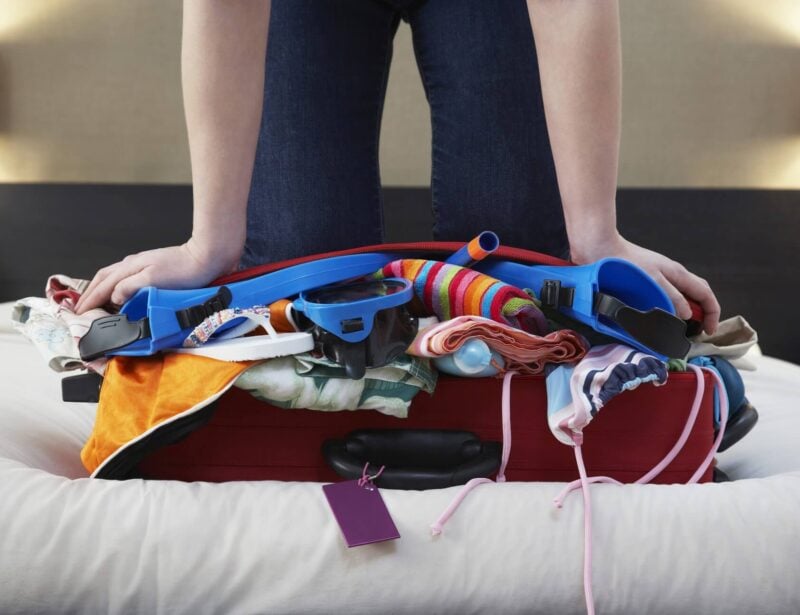
Wanna know how to pack like a pro? Well for a start you need the right gear….
These are packing cubes for the globetrotters and compression sacks for the real adventurers – these babies are a traveller’s best kept secret. They organise yo’ packing and minimise volume too so you can pack MORE.
Or, y’know… you can stick to just chucking it all in your backpack…
Get Yours Here Read Our ReviewPakistan Road Trip Route 2: The Northern Valleys Circuit
- From: Islamabad
- To: Fairy Meadows (Nanga Parbat Base Camp)
- Total Distance: 540 km (335 miles) + jeep ride + trek
- Days: 3-5
- Top Road Trip Stops: Babusar Pass, Raikot Bridge, Tato Village, Fairy Meadows
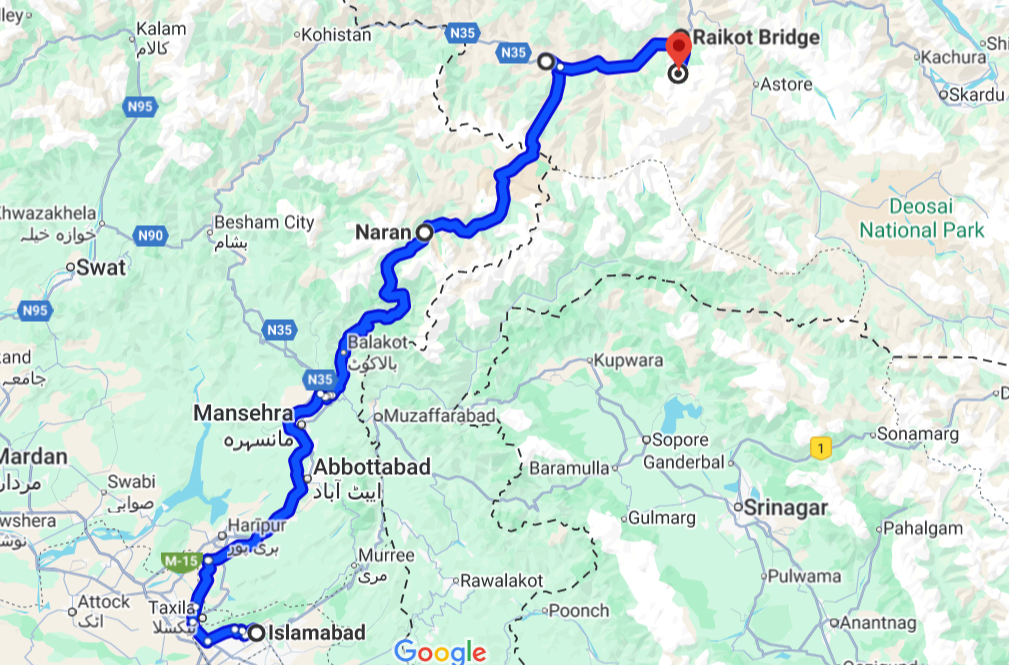
This is Pakistan’s road trip heavyweight, with snow-capped peaks, glacier rivers, and sky-high passes. This isn’t just a road trip, it’s a multi-stage adventure quest.
The journey to Fairy Meadows, one of Pakistan’s most famous trekking destinations, involves navigating mountain passes, and surviving one of the world’s most terrifying jeep rides. You’ll then be trekking through pine forests to reach an alpine meadow with front-row seats to Nanga Parbat – the world’s ninth-highest mountain.
Road Trip Highlights:
- Conquer the scenic Babusar Pass (4,173m) through stunning alpine terrain
- Experience the legendary “jeep ride from hell” from Raikot Bridge to Tato
- Trek through pristine pine forests to reach the famous Fairy Meadows
- Camp beneath Nanga Parbat (8,126m) – the “Killer Mountain”
Day 1: Islamabad to Naran (6-7 hours)

Starting from Islamabad, this route takes you through the Kaghan Valley, one of Pakistan’s most beautiful mountain valleys. The mountain town of Naran sits at the head of the valley, serving as the gateway to the high passes.
The drive up north is spectacular, following rushing rivers through pine forests with snow-capped peaks appearing around every bend. Stock up here, as it’s your last chance for proper supplies before going further into the wilderness.
- Best Stops: Kaghan Valley viewpoints, Saif-ul-Malook Lake turnoff, Naran’s mountain bazaar
- Where to Eat: Al-Noor Restaurant Balakot (stop en route), Bin Ishaq Restaurant B
- Where to Stay:
Day 2: Naran to Chilas via Babusar Pass (8-9 hours)

The Babusar Pass (4,173m) is one of Pakistan’s most spectacular and challenging mountain crossings. The road winds through terrain that looks like the edge of the world, with 360-degree mountain views.
The weather can change instantly up here, so start early and be prepared for everything from blazing sun to sudden snow. Chilas, your overnight stop, sits in the Indus Valley with a completely different desert mountain vibe.
- Best Stops: Babusar Pass summit (weather permitting), high-altitude lake stops, first views of Indus Valley
- Where to Eat: Roadside dhabas (local eateries)
- Where to Stay:
Day 3: Chilas to Fairy Meadows via Raikot Bridge (Full Adventure Day)
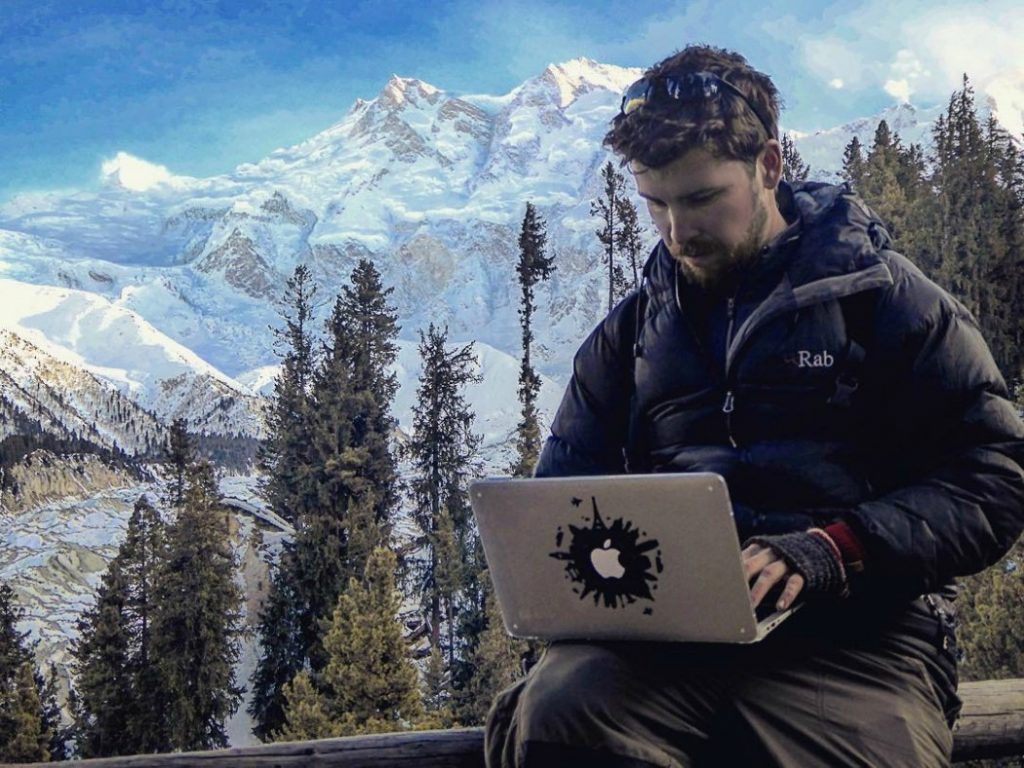
Drive to Raikot Bridge (1 hour), then buckle up for one of the world’s most notorious jeep rides – a bone-rattling, white-knuckle 2-hour journey up impossibly steep tracks to Tato Village. From there, it’s a 3-4 hour trek through pristine pine forests to reach Fairy Meadows. And trust us, the name fits perfectly. You’ll camp under some of the clearest night skies on Earth with Nanga Parbat looming overhead like a massive white wall.
- Best Stops: The jeep ride itself (survival achievement!), Tato Village (last civilization), pine forest trekking, Fairy Meadows arrival
- Where to Eat: Pack lunch, basic supplies at Tato, camping meals at Fairy Meadows
- Where to Stay: Camping at Fairy Meadows (bring gear)
Day 4: Fairy Meadows & Optional Base Camp Trek
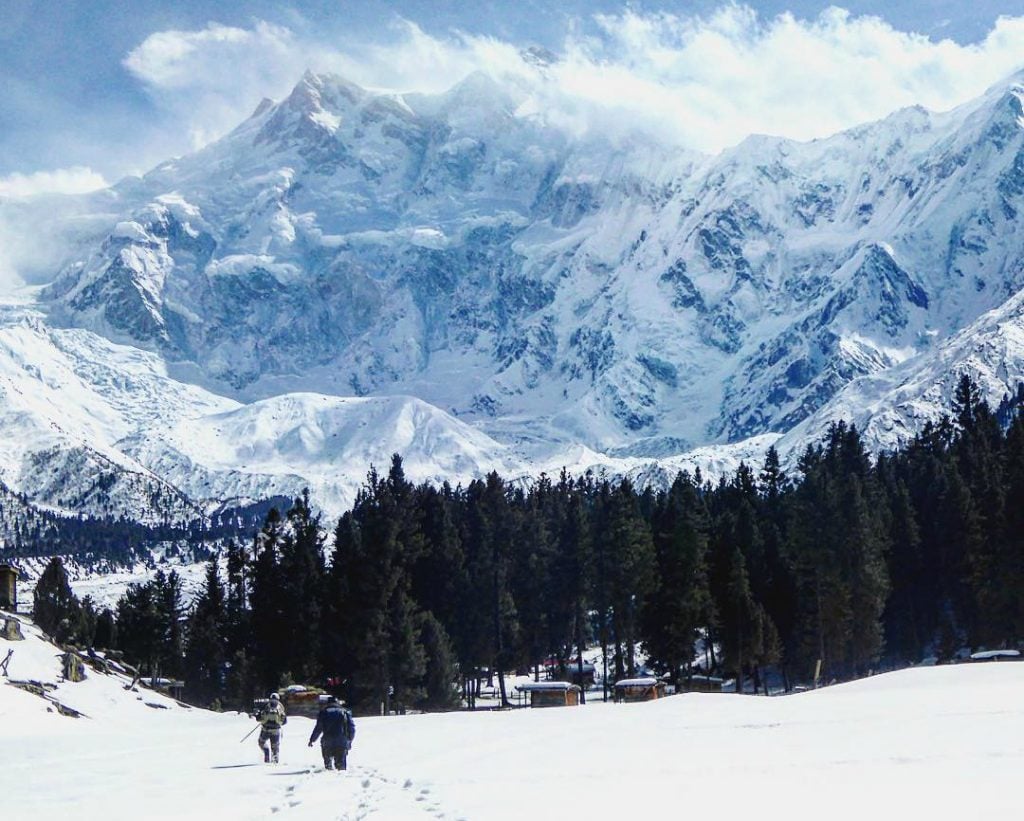
Time to wake up to a Nanga Parbat sunrise – an experience that’ll stay with you forever. Spend the day exploring the meadows, which look like something from a fairy tale, or push on to Nanga Parbat Base Camp (additional 2-3 hours each way) for the ultimate mountain experience.
The base camp trek – one of the best hikes in Pakistan – takes you across glacial moraines and river crossings with breathtaking views of the “Killer Mountain.” Even if you skip the base camp, just being at Fairy Meadows puts you in one of the most beautiful places on Earth.
- Best Stops: Sunrise/sunset photography, base camp trek (optional), meadow exploration, mountain meditation
- Where to Eat: Camping meals, basic supplies from huts
- Where to Stay: Same camping setup as Day 3
Day 5: Return Journey
The return follows the same epic route in reverse – another terrifying jeep ride, mountain driving through the Babusar Pass (weather permitting), and the gradual descent back to civilization. Many travelers find the return journey even more enjoyable because they’re more relaxed and can focus on the incredible scenery rather than navigation. Consider extending with stops you missed on the way up or push straight through if weather conditions are challenging.

A new country, a new contract, a new piece of plastic – booooring. Instead, buy an eSIM!
Jetpac eSIMs work just like an app: you download it, pick your plan, and BOOM! You’re connected the minute you land. It’s that easy.
Read about how eSIMs work or click below to see one of the top eSIM providers on the market and ditch the plastic.
Grab an eSIM!Pakistan Road Trip Route 3: The Makran Coastal Adventure
- From: Karachi
- To: Gwadar
- Total Distance: 650 km (400 miles)
- Days: 3-5
- Top Road Trip Stops: Hingol National Park, Princess of Hope, Kund Malir Beach, Ormara, Gwadar Port
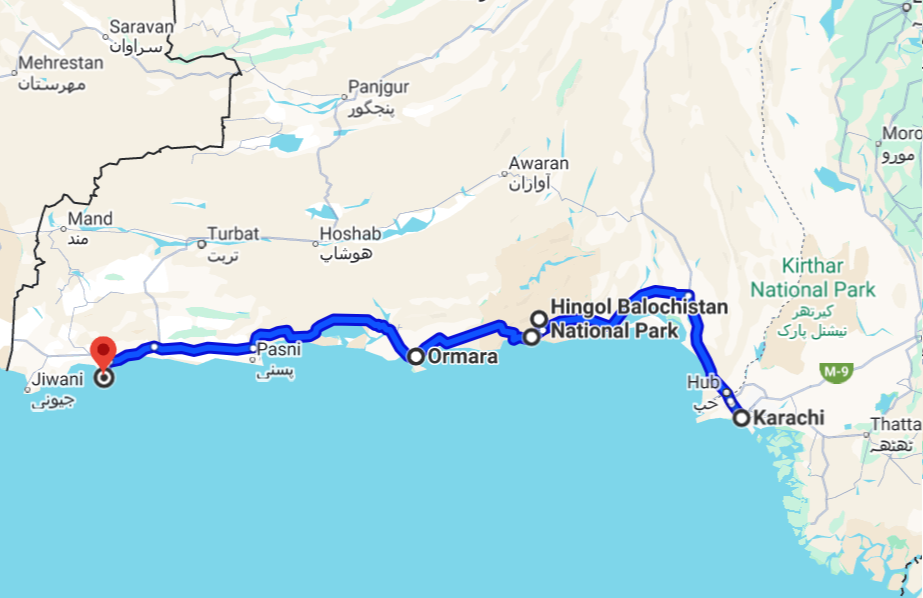
This is Pakistan’s most underrated road trip – a journey along a coastline where the desert meets the Arabian Sea in spectacular fashion. The Makran Coast offers other worldly landscapes that look more like Mars than Earth, and pristine beaches that see more dolphins than tourists.
The fascinating contrast between ancient Balochi culture and China’s futuristic port development in Gwadar is also a treat to watch. This road trip is perfect for adventurers seeking solitude, unique landscapes, and the chance to explore one of Asia’s last truly remote coastlines.
Road Trip Highlights:
- Drive through the surreal landscapes of Hingol National Park
- Marvel at the famous “Princess of Hope” rock formation
- Relax on pristine Kund Malir Beach with golden sand dunes meeting turquoise water
- Explore traditional fishing villages along the coast
Day 1: Karachi to Hingol National Park (5-6 hours)
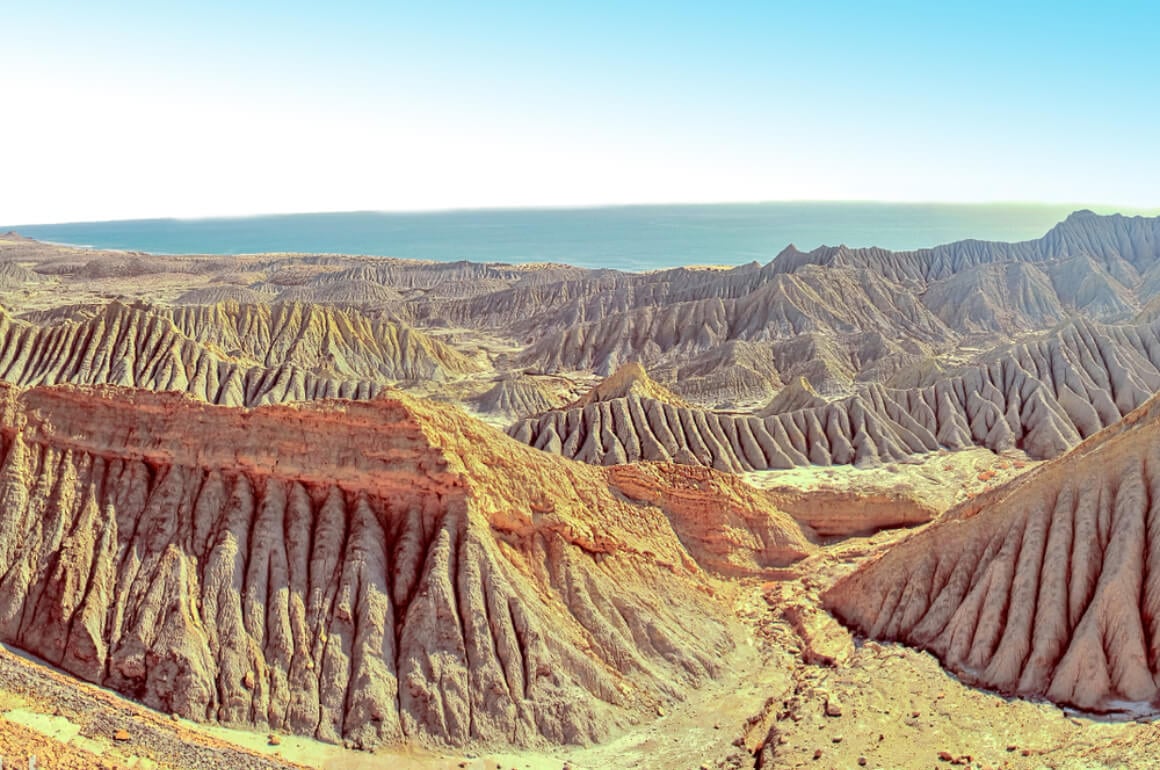
Escape Pakistan’s largest city for landscapes that’ll make you question which planet you’re on. The drive on this road trip will take you through arid terrain until you reach Hingol National Park, a place where desert, coast, and bizarre rock formations create fascinating scenery.
The famous “Princess of Hope” rock formation is your first major stop, a natural sculpture that’s become one of Pakistan’s most photographed landmarks. Camp under the clear star-filled skies here.
- Best Stops: Princess of Hope rock formation, Hingol River crossing, first coastal viewpoints
- Where to Eat: Pack supplies from Karachi, basic roadside stops, camping meals
- Where to Stay: Camping in Hingol National Park (bring gear), basic rest houses (pre-booking essential)
Day 2: Hingol to Kund Malir Beach (2-3 hours)
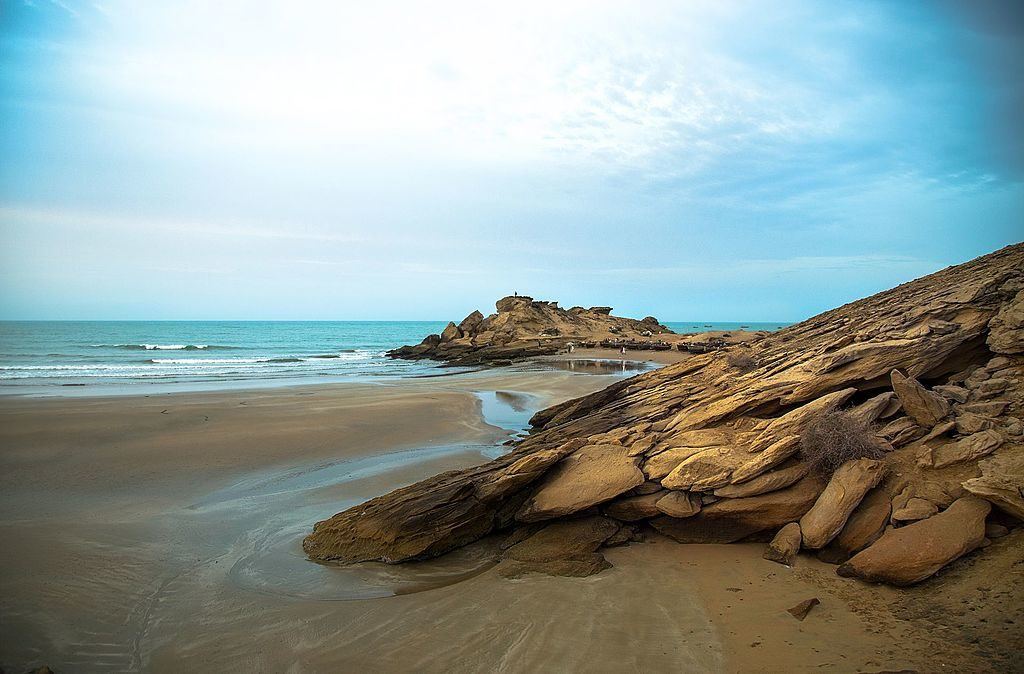
Day 2 of this road trip will have you in one of Pakistan’s most beautiful and remote beaches. Kund Malir is where massive golden sand dunes meet sprkling turquoise water, creating a landscape so perfect it almost looks artificial.
The beach stretches for kilometers. It’s just you, pristine sand, crashing waves, and the occasional camel caravan. Swim, surf, or just lie on empty beaches while dolphins play offshore. This is Pakistan’s best-kept coastal secret.
- Best Stops: Kund Malir Beach exploration, sand dune climbing, sunset photography, dolphin watching
- Where to Eat: Beach camping meals, basic supplies from local villages
- Where to Stay: Beach camping (magical but bring everything), basic guesthouses in nearby villages
Day 3: Kund Malir to Ormara (3-4 hours)

Continue along the coast to Ormara, a traditional fishing town that offers insight into Balochi coastal culture. The drive is along clifftops with endless ocean views, passing small old fishing villages.
Ormara itself is famous for its pretty beaches and excellent seafood. It’s the perfect place to experience authentic coastal Pakistan away from any tourist hangouts. The town’s fish markets, traditional boats, and laid-back vibe are fascinating. Watch for nesting turtles at Ormara’s beaches.
- Best Stops: Coastal viewpoints, traditional fishing villages, Ormara’s central fish market
- Where to Eat: Fresh seafood restaurants, Ormara Fish Market eateries
- Where to Stay:
- Gidan Beach Resort
- Local guesthouses, beachside camping
Day 4: Ormara to Gwadar (4-5 hours)
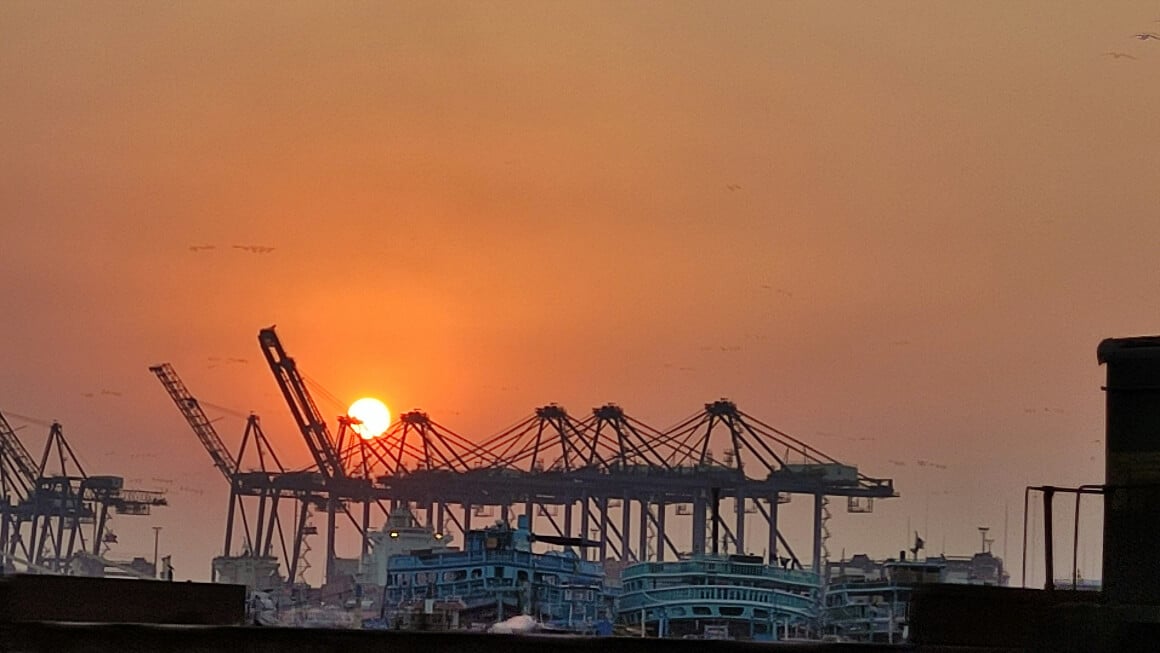
Your final day brings you to one of the most fascinating places in modern Pakistan: Gwadar, where ancient Balochi fishing culture meets China’s massive Belt and Road Initiative. The contrast is surreal: traditional dhows share the harbor with massive Chinese container ships. Gwadar offers excellent seafood, and the satisfaction of reaching one of Pakistan’s most remote corners.
Visit Gohar Beach, Sunset Park, or coordinate a boat trip around the port and beaches. The area is under development, but locals are welcoming. Keep tabs on checkpoints and security rules.
Important tips! Keep your car well?maintained, carry enough fuel and water, and avoid driving at night. Carry your passport for the ID checkpoints.
- Best Stops: Gwadar’s new port development, traditional fish harbors, viewpoints over the Arabian Sea
- Where to Eat: Local seafood joints
- Where to Stay:
- Pearl Continental Gwadar (best option)
- Sadaf Hotel, local guesthouses
Day 5: Gwadar Exploration & Optional Extensions
Use your final day to properly explore Gwadar’s contrasts. Visit both the old fishing town and the new Chinese-developed port areas. Consider boat trips to Astola Island (Pakistan’s largest offshore island), extended beach time, or cultural exchanges with local Balochi communities. The return journey can follow the same coastal route or cut inland through Turbat for different desert landscapes – both options offer their own rewards for the adventurous traveler.
Insurance in Pakistan
Third-party insurance is legally required in Pakistan, and rental cars include basic coverage. If you’re renting, the company should include minimal coverage, but it may not protect you in case of theft, damage, or roadside emergencies.
Pakistan’s roads can be unpredictable due to sudden weather changes as well, especially if you’re driving through mountain passes. I highly recommend getting full coverage or using a credit card that offers travel insurance. If you’re driving your own car from abroad, make sure you’re covered across borders and carry printed proof.
ALWAYS sort out your backpacker insurance before your trip. There’s plenty to choose from in that department, but a good place to start is Safety Wing.
They offer month-to-month payments, no lock-in contracts, and require absolutely no itineraries: that’s the exact kind of insurance long-term travellers and digital nomads need.
SafetyWing is cheap, easy, and admin-free: just sign up lickety-split so you can get back to it!
Click the button below to learn more about SafetyWing’s setup or read our insider review for the full tasty scoop.
What to Pack for a Road Trip in Pakistan
Here’s a packing list for your Pakistan road trip, blending practicality with off-grid essentials. This list works whether you’re cruising in a rental or living that van life:
- Essentials
- Passport
- Valid driver’s license + International Driving Permit (recommended)
- Offline maps (Google Maps / Maps.me)
- Cash (lots of rural areas are cash-only)
- Printed hotel bookings + ID for checkpoints
2. First Aid Kit: Even if you don’t plan on doing anything extreme on your trip, like hiking, climbing, or other extreme sports, you never know what could happen. You could cut yourself while cooking, smash a finger in a car door, or burn yourself on a hot radiator. A first aid kit will be able to handle most of these minor situations.
3. Aux Cord: One of the only things to do on a long car ride by yourself is to listen to music or a podcast. Since most people use their phones as an MP3 player these days, an auxiliary cord is crucial to preserving your sanity. If there is no auxiliary port in your car, buy a radio transceiver or use a portable speaker
4.Phone mount: It’s very dangerous to be looking down at your phone while driving. If you need to have access to your phone, for maps and whatnot, buy a mount for it. This way, you can keep your eyes on the road and your phone won’t be far from your field of view.
5. Headtorch: Every backpacker should have a head torch! A decent head torch could save your life. If you want to explore caves, unlit temples, or simply find your way to the bathroom during a blackout, a headtorch is a must. Currently, I’m using the Petzl Actik Core rechargeable headlamp – an awesome piece of kit! Because it’s USB chargeable I never have to buy earth-polluting batteries.
6. Roadside Emergency Kit: Just like you never know what could happen to yourself, one never knows what can happen to their car. A vehicle can mysteriously fail, break, run into a ditch; all that and then some. Most emergency kit include a pair of jumper cables, a tow rope, a set of essential tools, and ties.
7. Toiletry Bag: I always travel with a hanging toiletry bag as it’s a super-efficient way to organise your bathroom stuff. Well worth having, whether you are hanging it from a tree whilst camping, or a hook in a wall, it helps to have quick access to all your stuff.
For plenty more inspiration on what to pack, check out our full road trip packing list.
FAQs for Best Pakistan Road Trips
Final Thoughts on the Best Pakistan Road Trips
Pakistan isn’t just another road trip destination. It’s a complete game-changer that’ll redefine your understanding of adventure travel. Whether you’re chasing the ultimate high-altitude rush on the Karakoram Highway, seeking fairy-tale mountain beauty in Swat Valley, earning your wilderness stripes at Fairy Meadows, or discovering otherworldly coastal landscapes along Makran, Pakistan delivers experiences that money simply can’t buy elsewhere.
The beauty of road tripping here lies in the freedom to follow your instincts. Take detours to hidden villages, extend stays when places capture your heart, and connect with locals in ways that organized tours never allow. Each route offers something different: choose the Karakoram for bragging rights, Fairy Meadows for expedition vibes, or Makran for solitude and surreal landscapes.
Road tripping remains the absolute best way to experience Pakistan’s incredible diversity and legendary hospitality. Pack your sense of adventure, and prepare for a journey that’ll leave you planning your return before you’ve even reached home.
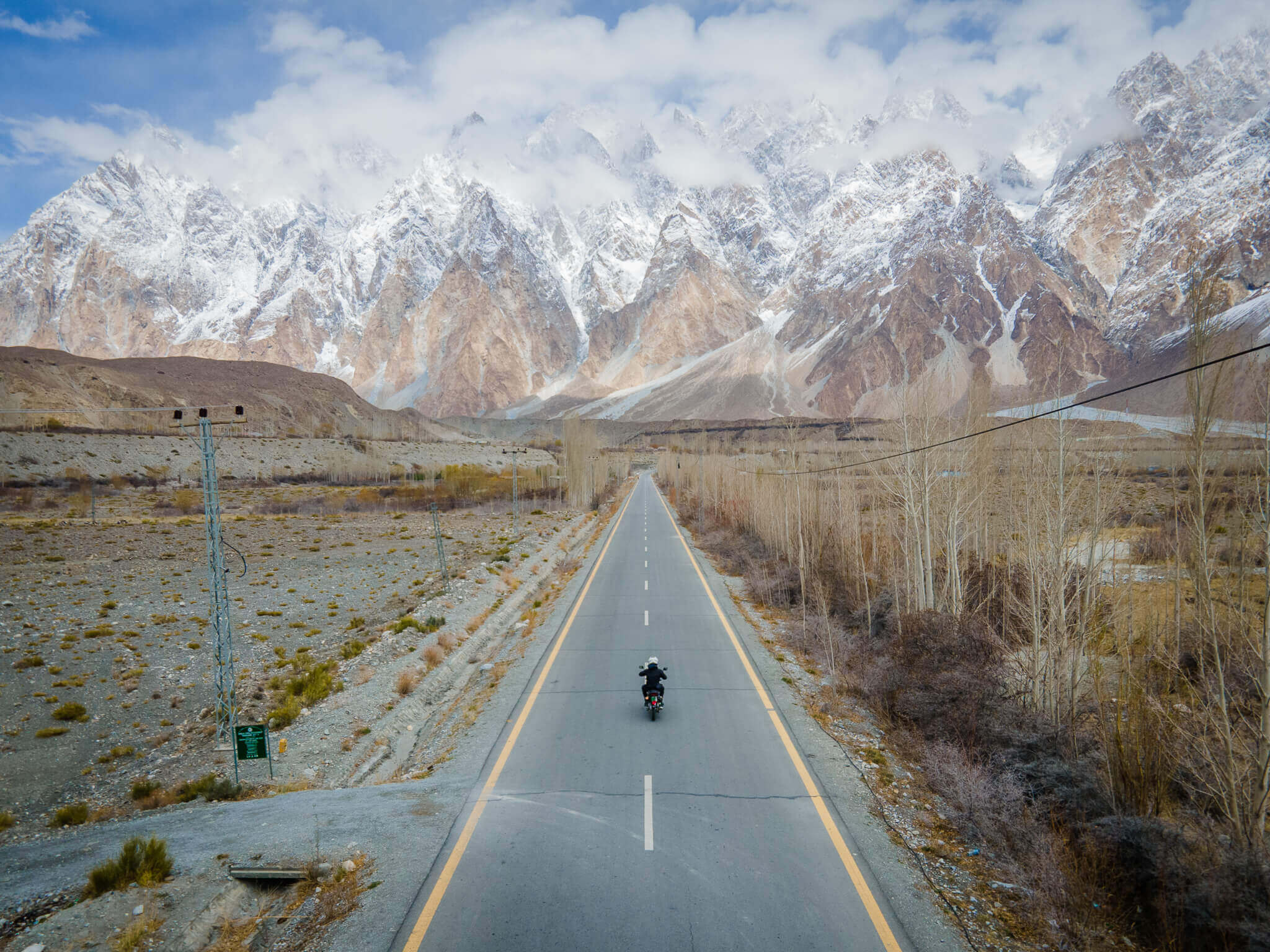
Image: Will Hatton
- Our in-depth Backpacking Pakistan guide has heaps of info for your trip.
- Plan your road trip around the most beautiful places in Pakistan to visit.
- This guide to the National Parks in Pakistan will also help you plan your itinerary.
- Backpackers and frugal travellers use our budget backpacking guide.
Buy Us a Coffee!
A couple of you lovely readers suggested we set up a tip jar for direct support as an alternative to booking through our links, since we’ve decided to keep the site ad-free. So here it is!
You can now buy The Broke Backpacker a coffee. If you like and use our content to plan your trips, it’s a much appreciated way to show appreciation 🙂



